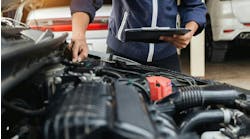The first successful four-wheel air suspension system was introduced on the Stout-Scarab, a limited-production car designed in 1933 by William Stout. GM introduced 4-wheel air suspension for production cars in 1958, and like Stout’s one-off system, it was complex, expensive and not completely reliable.
Ford introduced 4-Wheel Air Suspension (4WAS) on the 1995 Explorer, and has since made it available on all three generations of the Ford Expedition/Lincoln Navigator. These big trucks weigh about three tons, so they already have a relatively comfortable ride using conventional suspension. Air suspension smoothes that ride even further, but it’s also used to increase off-road ride height and for load-leveling, which enhances stability when towing.
Today, air suspension still costs more than conventional suspension, but thanks to modern materials and electronics, it is simpler, reliable and offers more than just a comfortable ride.
Operation
The 4WAS basically is the same as conventional suspension. Up front, the standard shock absorbers are replaced by air shocks, so there still are steel springs in the system. In the rear, the standard suspension’s coil springs are replaced with air springs. All four air units have a normally-closed solenoid valve that the control module operates for adding or venting air pressure. Changing pressure not only changes ride height, but it also changes spring rate. The solenoid valves on the rear air springs can be replaced, but the valves on the front air shocks cannot.
The electric air compressor is mounted behind the right headlight, and it’s different from the compressor on the Rear Air Suspension (RAS) system. It includes a built-in vent solenoid valve and a replaceable air dryer. The solenoid valve is also a spring-loaded safety valve that opens at 260 psi. Battery voltage is supplied to the compressor through a solid-state relay mounted below the headlight.
In addition to the compressor’s vent solenoid and the solenoid valve on each suspension unit, there are four more solenoid valves in the system. The front fill solenoid isolates the front air shocks from the rest of the system, and the rear fill solenoid isolates the rear air springs. The front gate solenoid isolates the front air shocks from each other, so the pressure between them does not equalize as the vehicle rolls in a turn. On smooth roads, this valve is opened for a softer ride. Finally, a pressure relief valve is mounted on the frame cross member near the rear height sensor. The control unit can use it to vent the rear air springs without having to open the rear fill and system vent solenoids.
On 2006 and earlier models, there are two linear ride height sensors, one mounted between the rear suspension panhard rod and the cross member just forward of the spare tire and one between the frame and the left front upper control arm. Even with only two sensors, the control unit is still capable of limited left/right height adjustments. The sensors have a total stroke of about three inches, which is how far the panhard rod and control arm move though the full 10 inches of suspension travel.
Sensor output is 0.25 volts at full extension and 4.75 volts at full compression. Adjusting the sensor or the static ride height of the truck requires a factory scan tool for storing the new settings in the 4WAS control unit.
Later models have four identical potentiometer-type sensors, one at each corner, but they’re permanently mounted to left- and right-side brackets so they can’t be interchanged. The bracket is bolted to the frame, and a small ball stud link connects the sensor arm to the suspension arm.
On earlier models, the same control unit is used for the 4WAS, the Rear Air Suspension (RAS) system and the EVO Steering Control Module. Mounted in the instrument panel above the radio, it supplies reference voltage to the height sensors and controls the ground circuit of the compressor relay and the power circuit of each solenoid valve. Inputs come either directly from sensors or from other modules, including the front Generic Control Module (GEM) and the PCM. Inputs include vehicle height, vehicle speed, steering wheel position, brake and accelerator pedal positions, transfer case gear selection, transmission gear selection and door ajar signals.
On later models, the Vehicle Dynamics Module (VDM), which is mounted above the parking brake handle, controls air suspension.
PAGE 2A manual Air Suspension Switch is used to turn the system off for service or long-term storage. On 1997-2002 models, the switch is behind the front passenger side kick panel. On newer models, it’s behind an access panel aft of the third-row seat on the driver side. That switch controls power to the control unit. When the switch is OFF, a warning light appears on the instrument panel with the ignition switch ON.
All of the air lines in the system are nylon. Two lines connect directly to the drier mounted on the compressor, one leading to the front fill solenoid valve and the other to the rear fill valve. Quick-connect fittings are used throughout the system. The air lines cannot be repaired or spliced.
When the ignition switch is first turned on, the control runs a self-diagnostic test. Any electrical or electronic problems detected are stored/displayed as B- or C-codes.
Any time a door or the rear hatch is opened, the system will remember the height sensor readings. If weight is added or removed, the system will operate as needed to maintain that height. Once the doors are all closed and vehicle speed exceeds 10 mph, ride height will be readjusted as needed. The system’s first priority is load leveling, but that’s not all it can do.
The control unit can select from three different programmed suspension heights. Trim height is the normal ride height for paved road. Off-road height is defined as trim plus 1 inch, and it’s engaged automatically when the ignition switch is ON, the transfer case is in 4X4 LOW and vehicle speed is less than 25 mph.
Kneel is defined as trim minus 1 inch, and it’s engaged when vehicle speed is zero, all doors are closed and the ignition switch is turned OFF. Obviously kneel is used to ease vehicle entry, and while one inch doesn’t seem like much, it can make a difference.
If a malfunction is detected, the system will default to trim height, either by operating the compressor or by venting pressure as needed.
Servicing
As noted earlier, there is a switch to turn the system off for service. It should be turned off any time the wheels are lifted off the ground. Failure to do so can cause expensive damage, especially to the rear air springs. The only service required by the 4WAS itself is a visual inspection. Look for physical damage to the air springs, cut or crimped air lines or evidence of something rubbing the lines. There is no pressure sensor in this system, so the self-diagnostic test can’t detect a leak. Symptoms of a leak include excessive compressor operation, failure to reach or maintain commanded height, and most commonly, a sagging rear end.
Soapy water can be used to leak-check the fittings, and the whole system can be checked with a smoke machine. Smoke is especially handy for finding a solenoid valve that’s open when it shouldn’t be, and vice-versa. Do not, under any circumstances, disconnect any fittings without venting the system first.
Height sensors also should be checked for damage and to make sure they’re securely mounted. With the vehicle at trim height, sensor output should be 2.66 volts. Repairing, adjusting or replacing a sensor requires a scan tool to recalibrate the system.
Historically the most troublesome part of the system is the compressor. Failures tend to be gradual rather than catastrophic, and tell-tales signs are noise, rough running and excessive current draw. The sagging rear end noted earlier is what commonly drives the customer to seek your help. When replacing a compressor, techs often replace the solid-state relay too.
After replacing a sensor or the control unit, the control unit will need to be calibrated. This involves setting mechanical ride height (with the system vented), then using a scan tool to command specific functions through the control unit. The Ford NGS and the new IDS tools are best for the job, but there are some purpose-built aftermarket tools available from companies that sell air suspension parts.
This brings us to the final point. Because the compressor is the part that fails most often, techs often just install a new part and “get lucky.” However if something else is wrong, the lack of proper tools, equipment, information and parts can turn a potentially profitable job into an ugly situation. Should you decide to make the investment, there are several companies that offer everything you need to become an air suspension specialist.


